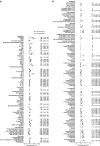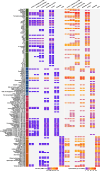Longitudinal metabolite and protein trajectories prior to diabetes mellitus diagnosis in Danish blood donors: a nested case-control study
- PMID: 39078488
- PMCID: PMC11446992
- DOI: 10.1007/s00125-024-06231-3
Longitudinal metabolite and protein trajectories prior to diabetes mellitus diagnosis in Danish blood donors: a nested case-control study
Abstract
Aims/hypothesis: Metabolic risk factors and plasma biomarkers for diabetes have previously been shown to change prior to a clinical diabetes diagnosis. However, these markers only cover a small subset of molecular biomarkers linked to the disease. In this study, we aimed to profile a more comprehensive set of molecular biomarkers and explore their temporal association with incident diabetes.
Methods: We performed a targeted analysis of 54 proteins and 171 metabolites and lipoprotein particles measured in three sequential samples spanning up to 11 years of follow-up in 324 individuals with incident diabetes and 359 individuals without diabetes in the Danish Blood Donor Study (DBDS) matched for sex and birth year distribution. We used linear mixed-effects models to identify temporal changes before a diabetes diagnosis, either for any incident diabetes diagnosis or for type 1 and type 2 diabetes mellitus diagnoses specifically. We further performed linear and non-linear feature selection, adding 28 polygenic risk scores to the biomarker pool. We tested the time-to-event prediction gain of the biomarkers with the highest variable importance, compared with selected clinical covariates and plasma glucose.
Results: We identified two proteins and 16 metabolites and lipoprotein particles whose levels changed temporally before diabetes diagnosis and for which the estimated marginal means were significant after FDR adjustment. Sixteen of these have not previously been described. Additionally, 75 biomarkers were consistently higher or lower in the years before a diabetes diagnosis. We identified a single temporal biomarker for type 1 diabetes, IL-17A/F, a cytokine that is associated with multiple other autoimmune diseases. Inclusion of 12 biomarkers improved the 10-year prediction of a diabetes diagnosis (i.e. the area under the receiver operating curve increased from 0.79 to 0.84), compared with clinical information and plasma glucose alone.
Conclusions/interpretation: Systemic molecular changes manifest in plasma several years before a diabetes diagnosis. A particular subset of biomarkers shows distinct, time-dependent patterns, offering potential as predictive markers for diabetes onset. Notably, these biomarkers show shared and distinct patterns between type 1 diabetes and type 2 diabetes. After independent replication, our findings may be used to develop new clinical prediction models.
Keywords: Molecular biomarkers; Multi-omics; Polygenic risk scores; Temporality; Time-to-event prediction; Type 1 diabetes mellitus; Type 2 diabetes mellitus.
© 2024. The Author(s).
Figures




References
-
- United Kingdom Prospective Diabetes Study Group (1995) United Kingdom Prospective Diabetes Study (UKPDS) 13: relative efficacy of randomly allocated diet, sulphonylurea, insulin, or metformin in patients with newly diagnosed non-insulin dependent diabetes followed for three years. BMJ 310(6972):83–88. 10.1136/bmj.310.6972.83 - PMC - PubMed
-
- Arcaro G, Cretti A, Balzano S et al (2002) Insulin causes endothelial dysfunction in humans. Circulation 105(5):576–582. 10.1161/hc0502.103333 - PubMed
MeSH terms
Substances
Grants and funding
LinkOut - more resources
Full Text Sources
Medical

